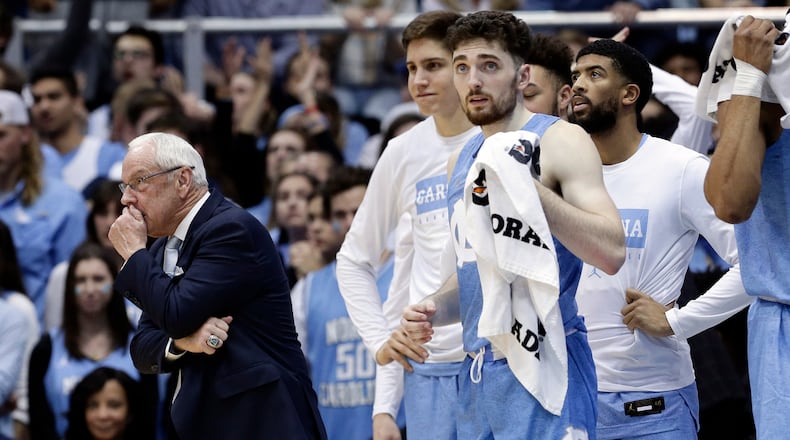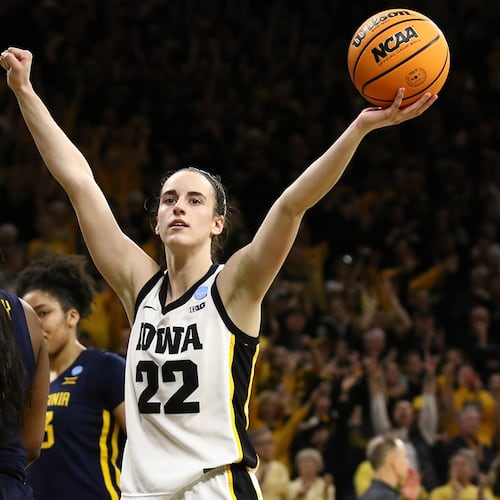The ACC plays the best basketball. You could look it up. Of the 20 NCAA titles taken since 2000, ACC teams have won eight. That’s more than the SEC (three), the Big 12 (one), the Big Ten (one) and the Pac-12 (zero) put together.
(You might quibble and say, “Maryland was one of those NCAA champs, and it’s no longer in the ACC.” My response would be, “Yeah, but Syracuse and Louisville, which won 21st Century titles in the Big East, have since joined the ACC. That’s a two-for-one trade.”)
In March 2013, Mike Krzyzewski spoke in Indianapolis ahead of Duke's regional final against Louisville, which was about to join the ACC. (The game itself is remembered for Kevin Ware of Conyers breaking his leg.) "For all these schools that have joined, it makes us the most powerful basketball conference, I think, ever," Krzyzewski said, and sure enough …
Over the past five seasons, ACC teams have won 74 games in the Big Dance. The previous five-year best by any league was 65, accomplished twice by, ahem, the ACC. Over the past 40 seasons, the ACC has been represented in the NCAA tournament 214 times — an average of 5.35 bids per year. Over the past 32 seasons, there has never been an NCAA tournament in which ACC representation went worse than .500.
Since the tournament expanded in 1985, ACC teams have reached the regional semis nearly half the time — 192 bids, 95 Sweet 16s. Last year the ACC exceeded itself, which at this late date is hard to do. It supplied three No. 1 seeds. That was a first for any league.
So now, 11 months later, we ask: What the heck happened?
ESPN's Bracketology, as compiled by Joe Lunardi, lists four ACC teams in his field of 68. Two are No. 2 seeds — Louisville, which plays at Georgia Tech on Wednesday, and Duke. Florida State, which lost at Duke on Monday, is a No. 3. We skip to the 11-line to find Virginia, the reigning champ. And that's it. (N.C. State is listed last among the "next four out.") From a 15-team league that has, over the past four years, sent 32 teams to the tournament, four bids.
Ken Pomeroy's rankings include Duke, Louisville and Florida State in the top 20. No other ACC school cracks the top 50. Virginia is No. 51 after its epic victory over Notre Dame on Tuesday, in which two teams working under esteemed coaches managed 99 points over 45 minutes. The Cavaliers won without making a basket in overtime.
We’ve said it before, and we’ll say it a bunch more in the month ahead: This is a soft year in college hoops. Much of that softness emanates from the ACC. Nine teams – 60 percent of the membership – are below .500 in league play. The gap between third-place FSU and fifth place N.C. State/Syracuse is three games.
Expansion has been good for the ACC in many ways, diversification among them. From 1997 through 2011, every ACC tournament save one was won by Duke or North Carolina. From 2012 through 2015, these were your ACC champs: Florida State, Miami, Virginia, Notre Dame. Nice.
The additions of Louisville (Adidas brouhaha notwithstanding) and Syracuse (Jim Boeheim’s Greensboro insults notwithstanding) lent oomph to an already-loaded league. That’s not to say this rising tide has lifted every boat. The 15-team ACC became top-heavy, which wasn’t great for those nearer the bottom.
Georgia Tech hasn’t reached the NCAA tournament since 2010. Boston College hasn’t made it since 2009. Wake Forest has made it once since 2010. Pitt has won one NCAA tournament game since joining in 2015 and, before this season, was 7-47 in ACC play over a three-year span.
Then there’s North Carolina, the blueblood’s blueblood. It’s 10-14, having lost 13 of 17. The Tar Heels were without hot freshman Cole Anthony for nearly two months; they’re 0-4 since he returned. Roy Williams has called this his “least gifted” Carolina team – even his 2010 NIT bunch won 20 games – and Ol’ Roy has had a rough year himself. He neglected to tell his men to foul while holding a late three-point lead against Clemson, which hit a tying trey and won in Chapel Hill for the first time ever.
The Heels lost to Saturday because they twice — twice! — failed to rebound missed Duke free throws. They went to Winston-Salem on Tuesday and were beaten by Wake Forest for the first time since 2014. They trailed by 18 at halftime. Afterward Anthony told reporters, “We didn’t listen to the scouting report,” which might (or might not) have included the line: “Try to rebound missed free throws.”
In other years, the Heels’ collapse would have left room at the top for mid-tier strivers. This year, the ACC doesn’t have much of a middle tier. The top three — Louisville, Duke and FSU — have lost a total of six conference games. Three of those came against each other.
Some of this was inevitable. The ACC had 10 players taken in Round 1 of the 2019 draft. Six were lottery picks. Virginia Tech lost Kerry Blackshear, who would have been the league’s best returning player, as a grad transfer to Florida. The three NCAA No. 1 seeds from last year — Virginia, Duke and Carolina — each had three players drafted and were essentially starting over. Duke, which is accustomed to the process, has handled it. Carolina hasn’t. Virginia is subsisting on defense: It has scored more than 65 points in one of its 13 ACC games.
There have been times when the ACC tournament semifinals could have passed for a Final Four. Last year’s semis: Virginia-FSU, Duke-Carolina, the lowest of those ranking No. 14 in the Associated Press poll. In 2017, the conference tournament featured a quarterfinal between No. 10 Louisville and No. 14 Duke. For glamour and star power, no other league can match the ACC — most years.
This year the ACC, which has sent at least six teams to each of the past six NCAA tournaments, mightn’t get five. Per Lunardi, five other leagues should get that many or more. The Big Ten is projected to dispatch 11 teams, and that’s not counting Minnesota, listed under the “first four out.”
The ACC has produced three of the past five national champs. No Big Ten team has won since 2000. This year, however, isn’t most years. This one’s weird.
About the Author
The Latest
Featured


